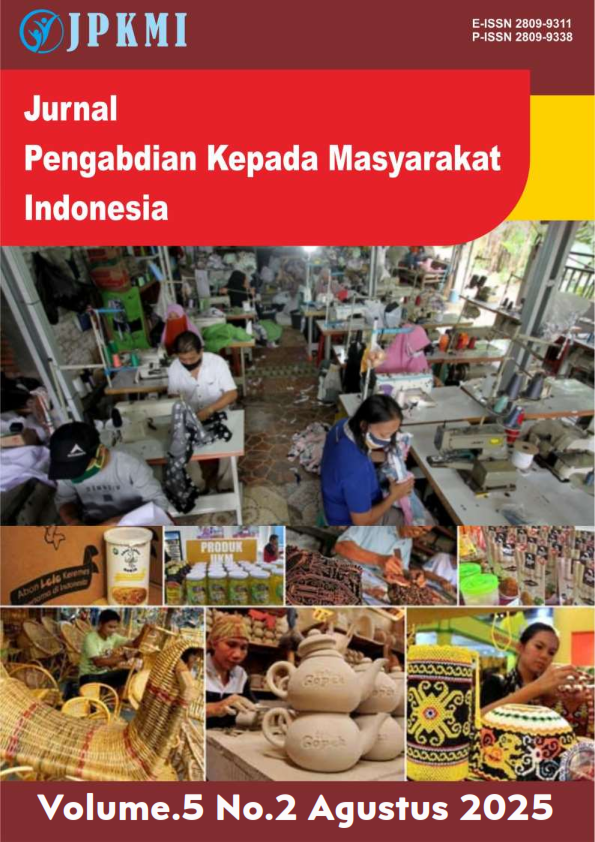Inovasi Pemetaan Talenta Siswa Menggunakan Platform Interaktif Studi Kasus : ( SMK XYZ )
DOI:
https://doi.org/10.55606/jpkmi.v5i2.6554Keywords:
Kata kunci: asesmen potensi , inovasi digital, pemetaan talenta, platform interaktif, siswaAbstract
Mapping student talents is an important step in supporting the development of potential and early career planning. However, conventional approaches such as written tests and manual observations are often considered inefficient and less engaging for students. This community service activity introduces an innovation in the form of an interactive platform specifically designed to map student talents in a more dynamic and enjoyable way. The platform combines educational elements with digital interaction, where students engage in a series of activities such as adaptive quizzes, case study simulations, and interest-based challenges. The data obtained in real-time is then analyzed to generate student potential profiles based on interests, cognitive tendencies, and learning styles.The results of implementation by a lecturer from another university who has applied one of these interactive platforms show that using such a platform increases student participation and provides a more accurate depiction of student talents compared to traditional methods. This innovation is expected to become an effective digital solution for schools in conducting continuous, data-driven assessments of student potential.
References
DAFTAR REFERENSI
Adiwibowo, T. G., & Harun, P. (2018). Analisis Efektivitas Talent Development Melalui Competency Mapping Dan Pengaruhnya Terhadap Corporate Performance. Jurnal Ilmu Manajemen & Ekonomika, 7(2), 131. https://doi.org/10.35384/jime.v7i2.85
Alden Nelson, Angeline, A., Angela Adriyanti Yang, Dennis Yang, Leonard Suryadi Yusuftan, & Whitney Ong. (2022). Talent Acquisition Dan Talent on Boarding Pada Industri Pariwisata Di Bintan. Jurnal Cakrawala Ilmiah, 2(4), 1505–1522. https://doi.org/10.53625/jcijurnalcakrawalailmiah.v2i4.4338
game talent maping. (n.d.).
Illahi, R. K., Islam, U., Imam, N., Padang, B., & Pawiyatan, M. I. (2019). Jurnal Al-Taujih. 5(2), 158–168.
Mukti, Y. I. (2020). Sistem Prediksi Lulus Tepat Waktu Tugas Akhir Mahasiswa Menggunakan Support Vector Machine (Svm). JUTIM (Jurnal Teknik Informatika Musirawas), 5(2), 110–115. https://doi.org/10.32767/jutim.v5i2.1050
Mumpuni, S. D. (2018). Peran Guru Bimbingan Dan Konseling Dalam Meningkatkan Motivasi Belajar Peserta Didik Dalam Menghadapi Ujian Nasional Kelas Xi (Studi Kasus di SMAN 2 Kota Tegal). Suluh: Jurnal Bimbingan Dan Konseling, 3(2), 36–40. https://doi.org/10.33084/suluh.v3i2.506
Satryawati, E., Ikhsan, M., Fenty, S., & Julfia, T. (2023). Penerapan Talents Mapping Digital Pada Siswa Sekolah Menengah Kejuruan Islam Al Hikmah Jakarta. 5(1), 117–123.
Sholehah, A. M., & Putro, K. Z. (2022). Anak Berbakat (Jenius Atau Gifted Children). Indonesian Journal of Early Childhood: Jurnal Dunia Anak Usia Dini, 4(1), 304. https://doi.org/10.35473/ijec.v4i1.996
Syamsu Yusuf. (2004). Psikologi Perkembangan. Remaja Rosdakarya.
Washillah, M. H., Prabawani, B., & Nugraha, H. S. (2024). Analisis Talent Development Strategy di Era Revolusi Industri 4 . 0 ( Studi Kasus Pada PT Telkom Indonesia Regional IV Jateng-DIY ). 13(2), 107–116.
Zakaria, Sukomardojo, T., Sugiyem, Razali, G., & Iskandar. (2023). Menyiapkan Siswa untuk Karir Masa Depan Melalui Pendidikan Berbasis Teknologi : Meninjau Peran Penting Kecerdasan Buatan. Journal on Education, 5(04), 14141–14155. http://jonedu.org/index.php/joe
Downloads
Published
How to Cite
Issue
Section
License
Copyright (c) 2025 Jurnal Pengabdian kepada Masyarakat Indonesia (JPKMI)

This work is licensed under a Creative Commons Attribution-ShareAlike 4.0 International License.









